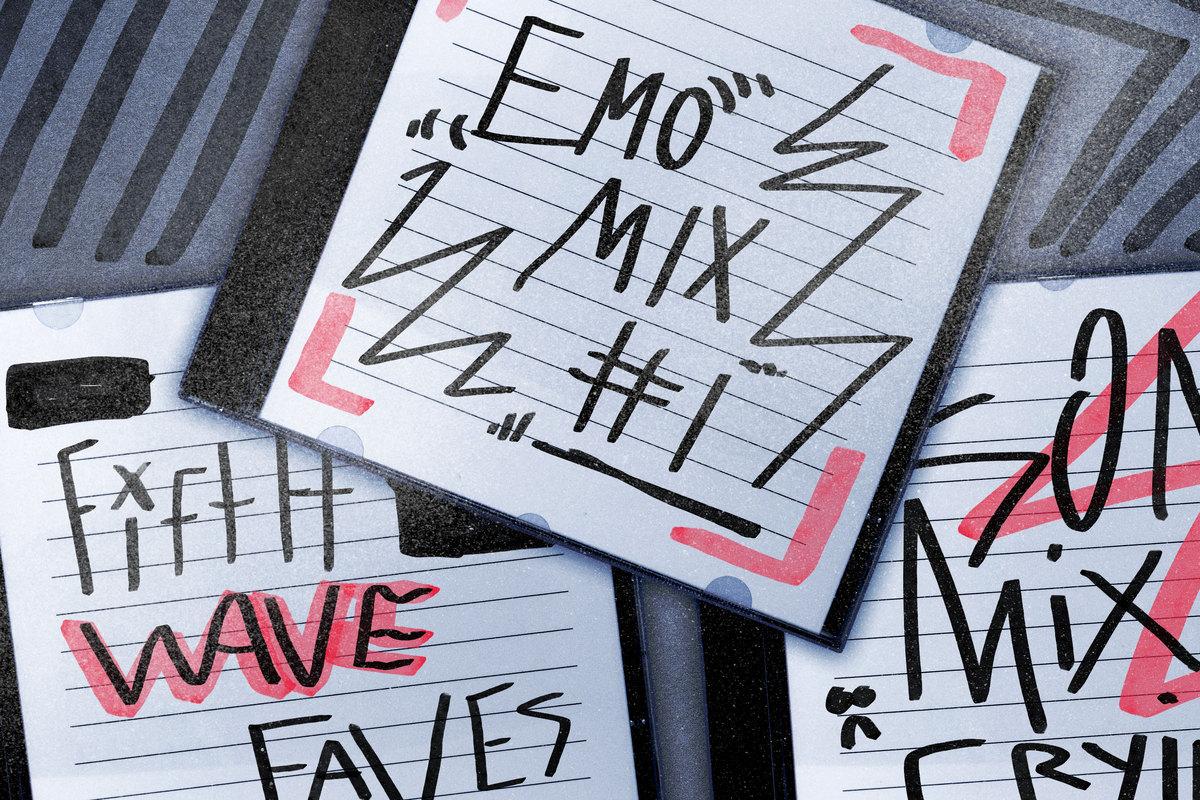
My Chemical Romance is touring again, Paramore and Jimmy Eat World are headlining a major festival this fall, and there’s a skinny, tattooed white dude with a guitar dominating the charts. In case you haven’t heard, emo is back, baby! In honor of its return to prominence—plus the 20th anniversary of the first MCR album—The Ringer is following Emo Wendy’s lead and tapping into that nostalgia. Welcome to Emo Week, where we’ll explore the scene’s roots, its evolution to the modern-day Fifth Wave, and some of the ephemera around the genre. Grab your Telecasters and Manic Panic and join us in the Black Parade.
To kick off Emo Week on Monday, Ringer contributors Ian Cohen and Arielle Gordon brought you a list of 38 of the genre’s defining songs. It was a comprehensive overview of a hard-to-pin-down style of music, covering several decades and many more subsects. Today, we bring you something a little different: our niche emo interests. (Yes, even subgenres have subgenres.) What follows is a dozen or so playlists covering emo and emo-adjacent things, from scenes to movements to specific artists to whatever inspired us. Let us know what you think and tweet your own to us @ringer.
Skipping Disc-Man in the Messenger Bag: The Class of 1997-ish
Compiled by: Chris Ryan
A compilation of Jade Tree and Jade Tree–adjacent music circa 1997, courtesy one half of The Ringer’s favorite emo tag team, The Watch.
A Beginner’s Guide to Skramz
Compiled by: Arielle Gordon
Screamo isn’t, despite its name, just any music with screamed vocals. It’s more extreme and guttural than the roars that open “Oh Messy Life”; it’s more impassioned—more soulful even—than Ian MacKaye’s shouts of “I don’t smoke! I don’t drink! I don’t FUCK!” on “Out of Step.” Massachusetts’ Orchid was one of the earliest bands to make the transition from traditional hardcore to the slower, more brutal pace of screamo in the late ’90s; bands like Pg. 99 and Saetia soon expanded the primarily East Coast scene.
By the mid-2000s, fans began calling it “skramz” as an inside joke and as a way to distinguish the first wave of bands from more mainstream successors. It’s a helpful distinguisher if you really want to dunk on some 12-year-old on /mu/. Whatever you call it, a new generation of bands like foxtails and I Hate Sex have picked up the shredded vocals torch and added their own spin on one of emo’s most divisive subgenres.
Non-Dudes in Emo Music, Then and Now
Compiled by: Justin Sayles
There’s more to emo than just a bunch of heartbroken dudes. From Fire Party and Rainer Maria to Camp Cope and awakebutstillinbed, there have been plenty of women and nonbinary artists who have defined the genre and its many tentacles. Here’s a small sampling.
Second-Wave Emo’s “Flop Era,” 2002-06
Compiled by: Ian Cohen
By 2002, Jimmy Eat World had arose from a major-label washout as platinum-selling superstars; Death Cab for Cutie and Bright Eyes, once artists peripheral to their respective scene and in thrall to their influences, emerged as central nodes between emo and indie; Chris Carrabba picked up an acoustic guitar, ditched the church basement emo of Further Seems Forever, and became the genre’s first true solo star as Dashboard Confessional. While just about every one of their second-wave peers was in a similar state of transition at that time, most of them made a pivot toward the mainstream that alienated older fans and failed to gain new ones in equal measure. Some were literal career killers, others required immediate course correction, but every one of these bands got subsumed by an incoming wave of radio-ready emo that skewed more pop and pinup from the start. But I use the term “flop era” affectionately: Just about all of the songs here have become cult favorites in the time since, and with emo’s full absorption into Big Indie one decade later, all of these bands—whether through reunion tours, reunion albums, or deluxe reissues—were able to reap the rewards of being ahead of their time.
An Intro to Emogaze
Compiled by: Arielle Gordon
Shoegaze, the genre named for its musicians’ tendencies to stare at their shoes (or really, their complicated pedalboards), has traditionally accompanied soft, elven voices like Slowdive’s Rachel Goswell or My Bloody Valentine’s Bilinda Butcher. But with the help of producers like Jack Shirley and Zac Montez, heavier bands have begun to embrace the dense, swirling guitars of the primarily British genre. Bands like Cloakroom and Nothing don’t just occasionally share members; they share a similarly sludgy, distorted approach to match their dark, existential lyrics.
The Brightside: Lil Peep’s Most Emo
Compiled by: Justin Sayles
The once “future of emo,” the rap-adjacent/emo-adjacent vocalist who flipped Mineral and Microphones samples, died five years ago this November. His legacy continues to thrive.
The Overwrought Emo Breakup Playlist
Compiled by: Justin Verrier
It’s easy to spot an emo song. Crunchy guitars. Earworm choruses. And unhinged suffering over a past relationship. This list attempts to capture some of the best melodramatic heartbreak songs of the genre, ranging from bellowing “How could you do this to me?” to digging out someone’s eyeballs with a spoon and swallowing them.
Fourth-Wave Kings: The Best of Modern Baseball
Compiled by: Dan Comer
No music video captured fourth-wave emo quite like Modern Baseball’s masterpiece “The Weekend.” The DIY house party, the mosh pits, the impromptu tattoo session, the unattainable hipster with glasses. This was the Philly quartet at its best. Whatever, forever.
Going for the Gold: Saddle Creek Emo 101
Compiled by: Justin Sayles
The great Omaha record label Saddle Creek is more of an indie rock operation, but they’ve still put out their share of great emo. That’s most notably come from Cursive and Bright Eyes (and Commander Venus, the early collaboration between those bands’ principals). But let us submit to you that Rilo Kiley also has at least one great emo song: “The Good That Won’t Come Out,” if only for the lines, “I think I’ll go out and embarrass myself / By getting drunk and falling down in the street / You say I choose sadness / That it never once has chosen me / Maybe you’re right.”
Our Backpack Could Be Your Life: Circa-Y2K Underground Emo Rap
Compiled by: Keith Fujimoto
Backpack rap kids and emo kids had a lot in common: bottled-up frustration and a yearning to be understood. A plethora of rappers’ angsty pens flowed mightily in the late ’90s and early 2000s. These were some of the songs highlighting the most memorable jawns from that era.
The Post-Hardcore Black Belts: The Return of Karate
Compiled by: Justin Sayles
This legendary Boston-born quartet would loathe to be included in a roundup of “emo” playlists. But while their music may hew closer to the core side of the emo-core divide, they’re freshly reunited, have a gang of Numero Group reissues, and still pretty fucking good. Here’s a sampling of their music, which ranges from rock to jazz to, well, emo.
Fifth-Wave or Post-Emo?
Compiled by: Ian Cohen
The timeline for Fifth-Wave emo can broadly be framed as “anything that happened after 2017 or so.” But the animating spirit of the movement is perhaps better exemplified by the concept of “post-emo,” a constructive, optimistic ethos of radical inclusivity that stridently defines itself as anti-revival. Bands of this ilk center marginalized voices across race, gender, and sexuality; forgo American Football and Jawbreaker as primary influences in favor of the anything-goes experimentalism of Brave Little Abacus and Crying; loudly declare themselves as emo rather than evade the term to endear themselves to indie audiences. If most of this music is barely recognizable as “emo,” that’s kind of the point—the future of emo is whatever these bands are making it.
It’s Giving Emo: The Bandsplain Chaotic Guide to Emo
Compiled by: Yasi Salek
Lastly, friend of the site and host of our favorite four-hour podcast offers up an eclectic mix from emo’s rich history. (Plus some Third Eye Blind and Goo Goo Dolls.)
For more music playlists, follow The Ringer on Spotify.

